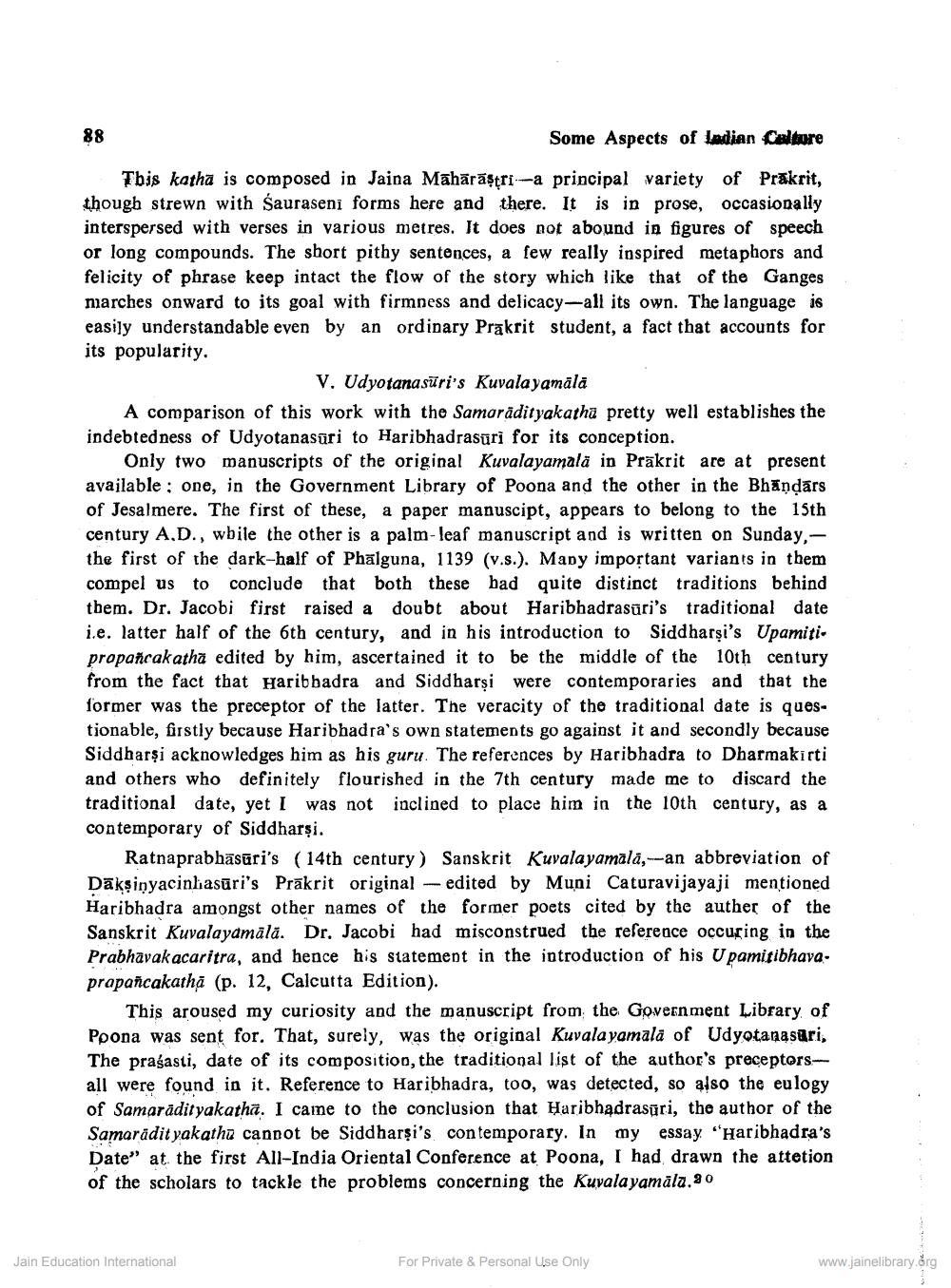________________
88
Some Aspects of Indian Culture
Tbis katha is composed in Jaina Mahārāștri -a principal variety of Prakrit, though strewn with Sauraseni forms here and there. It is in prose, occasionally interspersed with verses in various metres. It does not abound in figures of speech or long compounds. The short pithy sentences, a few really inspired metaphors and felicity of phrase keep intact the flow of the story which like that of the Ganges marches onward to its goal with firmness and delicacy-all its own. The language is easily understandable even by an ordinary Prakrit student, a fact that accounts for its popularity.
V. Udyotanasūri's Kuvalayamāla A comparison of this work with the Samarādityakatha pretty well establishes the indebtedness of Udyotanasuri to Haribhadrasuri for its conception.
Only two manuscripts of the original Kuvalayamala in Prakrit are at present available : one, in the Government Library of Poona and the other in the Bhandars of Jesalmere. The first of these, a paper manuscipt, appears to belong to the 15th century A.D., wbile the other is a palm-leaf manuscript and is written on Sunday,the first of the dark-half of Phalguna, 1139 (v.s.). Many important variants in them compel us to conclude that both these bad quite distinct traditions behind them. Dr. Jacobi first raised a doubt about Haribhadrasūri's traditional date i.e. latter half of the 6th century, and in his introduction to Siddharşi's Upamiti. propañcakatha edited by him, ascertained it to be the middle of the 10th century from the fact that Haribbadra and Siddharşi were contemporaries and that the former was the preceptor of the latter. The veracity of the traditional date is ques. tionable, firstly because Haribhadra's own statements go against it and secondly because Siddharşi acknowledges him as his guru. The references by Haribhadra to Dharmakirti and others who definitely flourished in the 7th century made me to discard the traditional date, yet I was not inclined to place him in the 10th century, as a contemporary of Siddharşi.
Ratnaprabhāsūri's (14th century) Sanskrit Kuvalayamala --an abbreviation of Daksinyacinliasūri's Prākrit original - edited by Muni Caturavijayaji mentioned Haribhadra amongst other names of the former poets cited by the auther of the Sanskrit Kuvalayamālā. Dr. Jacobi had misconstrued the reference occuring in the Prabhavak acaritra, and hence his statement in the introduction of his U pamitibhava. prapañcakathā (p. 12, Calcutta Edition).
This aroused my curiosity and the manuscript from the Government Library of Poona was sent for. That, surely, was the original Kuvalayamala of Udyotanasari, The prasasti, date of its composition, the traditional list of the author's preceptorsall were found in it. Reference to Haribhadra, too, was detected, so also the eulogy of Samarādityakatha. I came to the conclusion that Haribhadrasūri, the author of the Samarádit yakatha cannot be Siddharşi's contemporary. In my essay "Haribhadra's Date" at the first All-India Oriental Conference at Poona, I had drawn the attetion of the scholars to tackle the problems concerning the Kuvalayamāla.20
Jain Education International
For Private & Personal use only
www.jainelibrary.org




